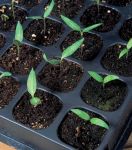Seeds & Cuttings

GROWING FROM CUTTINGS
Cuttings fall into three main groups, but whichever method you use it is essential that cuttings are taken from healthy plants:
- hardwood
- softwood
- semi-ripe
HARDWOOD CUTTINGS
- Taking hardwood cuttings is one of the easiest ways to produce new plants of Salix (willow),
- Deutzia and many other woody shrubs, and only needs secateurs.
- From autumn to early spring, select shoots produced the pre-vious spring and summer. Only select strong growth and remove near its base or point of origin.
- These shoots – about the thick-ness of a pencil and 23–25cm long – should be cut square below a bud to form a base, at an angle of 35 degrees.
Rooting:
- Treat the bottom 3cm of each cutting with rooting hormone.
- Insert the prepared cuttings into a 12–15cm trench made in well dug garden soil with a 5cm layer of sharp sand for drainage.
- Alternatively plant three or four cuttings in a pot of multi-purpose or cutting compost and place in a cold frame or sheltered part of the garden. The following autumn the rooted cuttings can be carefully planted out in their final growing positions.
SOFTWOOD CUTTINGS
- These are taken in early to late spring to grow many semi-ten-der plants such as pelargoniums and fuchsias, herbaceous plants and some alpines. Young growth on shrubs such as Rosmarinus (rosemary), Artemisia (worm-wood) and Lavandula (lavender) may also respond well.
- In spring, remove shoots from the parent plant once they are firm enough to handle and not too soft to lose their rigidity.
- Using a sharp knife or secateurs, prepare the cutting by making a cut at an angle of 35 degrees at the base of the chosen shoot.
- Cuttings should be 5–10cm long according to plant variety. If the leaves are alternate on the shoot, make the upper cut four leaf joints above the first cut.
- If the leaves are opposite, make the cut above the second pair of leaves. In both cases make cuts from the buds in the leaf joint.
- Gently remove the lower leaves. If the remaining leaves are more than 3cm long, halve them with a knife, to cut down moisture loss during the pre-rooting period.
Rooting:
- Dip the bottom 3cm of the pre-pared cutting into water. Shake off the surplus then roll the bottom 2.5cm in rooting hormone.
- Insert cuttings into seed trays or pots containing sharp sand.
- Place the tray or pot into a propagator – preferably one with a heating control.
- Close all vents and shade the cover with a newspaper. After 7–10 days, open the vents and remove the shading.
- Once the cuttings make new shoots at the leaf joints, this is a good indication that rooting has taken place. Remove the tray or pot from the propagator.
- When new growth on the rooted cuttings reaches more than 3cm long, pot them into individual pots of general potting compost.
- In four to six weeks they should be large enough to plant in their final growing positions, provided all risk of frost has passed.
SEMI-RIPE CUTTINGS
- Semi-ripe cuttings of many shrubs and climbers can be taken in late spring to midsummer. Success is not guaranteed but it’s worth a try.
- The method or preparation is the same as for softwood cuttings, but use shoots from the current season’s growth that have begun to firm.
- The use of a propagator is more important and the availability of controllable heat will enhance the success rate. Rooting is slower than softwood cuttings but once new growth has reached 3cm the cuttings can be potted on into individual pots.
- Grow young plants on in a frost free light-protected environment such as a greenhouse or garden frame with no additional heat. Plant out in the garden or into larger pots the following spring or autumn.



